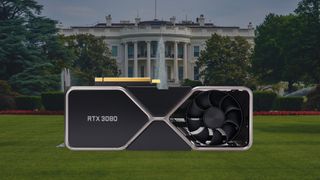Nvidia has requested President Biden's help to get more RTX 3060s and RTX 3080s to the US
No promises though

Nvidia has teamed up with HP and Zotac to request that the Biden administration exempt graphics cards from the current Trump-era US tariffs on imported Chinese tech.
As reported by PCMag, all three companies submitted the request to the US Trade Representative (USTR), citing a distinct lack of GPU manufacturing outside of China which has resulted in them being affected by the 25% duty on Chinese-manufactured hardware.
On the submission, when asked to explain its rationale for the request, Nvidia said "The products are not manufactured in the U.S. and in only limited amounts in Taiwan. Efforts to create new capacity in countries that presently do not manufacture such products (such as the U.S. and Vietnam) were unsuccessful and were severely hampered by the fallout from COVID-19."
The Covid-19 pandemic was cited as a reason not just for reduced stock being shipped to countries like the US, but also reduced manufacturing capacity, with Nvidia claiming "The ability to move the supply chain and/or increase volume in other countries was negatively impacted by COVID-19 in terms of the severe constraints in cargo/air freight capacity, the ability to operate facilities in people-intensive manufacturing, and the ability to find and hire qualified employees trained in such manufacturing".
Why don't we just make more?
In an ideal world, the tech giant would have been able to erect additional manufacturing facilities to cope with increased demand. However, Nvidia also states that it was affected by the ongoing chip shortage, saying "Given the limits on supply of semiconductors, it also would have been the wrong time to face lower yields that are associated with new sites."
In its own request, HP also claims that the tariffs are causing issues getting graphics cards over to the States, claiming "The global shortage of silicon has had a significant impact on graphics processing units/graphics cards, in particular, increasing costs and limiting any possibility of alternative supplies. Given China’s role as a hub for back-end production of graphics cards, sourcing the item in a third country at sufficient volume is not currently possible. The additional China 301 tariffs make these critical computer components cost-prohibitive for US bus"
Team green and co are also not the only computing brand to have requested help from the US government, with Intel seeking federal assistance from the United States a few weeks ago. A request was made to increase current production output and additional research within the US, while also proposing to use a factory based in Chengdu to have something set up and running by late 2022, but this was rejected due to the current trading restrictions with China.
Get daily insight, inspiration and deals in your inbox
Get the hottest deals available in your inbox plus news, reviews, opinion, analysis and more from the TechRadar team.
In that instance, a White House representative stated that the administration is “very focused on preventing China from using US technologies, know-how and investment to develop state-of-the-art capabilities", so its anyone guess if the Biden administration will be willing to budge on its current tariff policies
With the current silicon shortage expected to last into 2023 by some industry experts, it's likely that we're going to have a hard time snagging in-demand tech like Nvidia GeForce graphics cards for the foreseeable future unless stock somehow becomes plentiful - which is unlikely given how many factors would need to change to make that happen.
Analysis: Would consumers see the benefit anyway?
The information on the USTR Comments Portal is sparse, but it's notable that it doesn't state that if permission is granted that consumers will actually see cheaper GPUs on the shelf, nor does it clarify if that tariff is currently being covered by Nvidia or if that additional cash is factored into the retail price of current cards.
It isn't as easy to just demand that these GPUs are manufactured in the US either as the cost of building new production facilities is also no small task, especially if the current global issues can be resolved in the next few years to ensure that current factories and plants are equipped sufficiently to cope with future product releases.
Reddit User BluudLust weighed in on a thread discussing the issue, saying "It takes 2 years to build a new fab. And a further year or two to tool it to the latest process. Then you have a distinct lack of skilled labor, so you'd have to import them from Taiwan until you can train enough Americans.
It'll cost more than $10 billion to do and unless the government subsidizes that, it isn't happening. TSMC already has thin margins and are pretty much propped up by the Taiwanese government with absurd tax cuts, etc"
HP mentioned in its submission that manufacturing the USA also isn't possible right now, saying "there are no U.S. factories producing graphics cards that we are aware of, and none can produce the replacement cards at the quality, compatibility and capacity needed".
PCMag also reported that brands such as Asus, EVGA, and Zotac raised prices on their products during the height of the chip shortage as a result of the current tariffs that were introduced by Trump back in January 2021
Essentially there's no guarantee that if the Biden administration actually approves these requests that we, the consumers, will see an immediate reduction in the cost of GPUs, though the main issue driving up the prices at third-party retailers is scarcity. If the market can be flooded with fresh inventory, the inflated prices we're seeing should drop and scalpers will have no reason to buy up all the available stock.
At this point we're hoping for a miracle, but regardless of the outcome we likely won't see any difference at all until 2023.
- We'll show you how to build a PC
Jess is a former TechRadar Computing writer, where she covered all aspects of Mac and PC hardware, including PC gaming and peripherals. She has been interviewed as an industry expert for the BBC, and while her educational background was in prosthetics and model-making, her true love is in tech and she has built numerous desktop computers over the last 10 years for gaming and content creation. Jess is now a journalist at The Verge.
Most Popular




